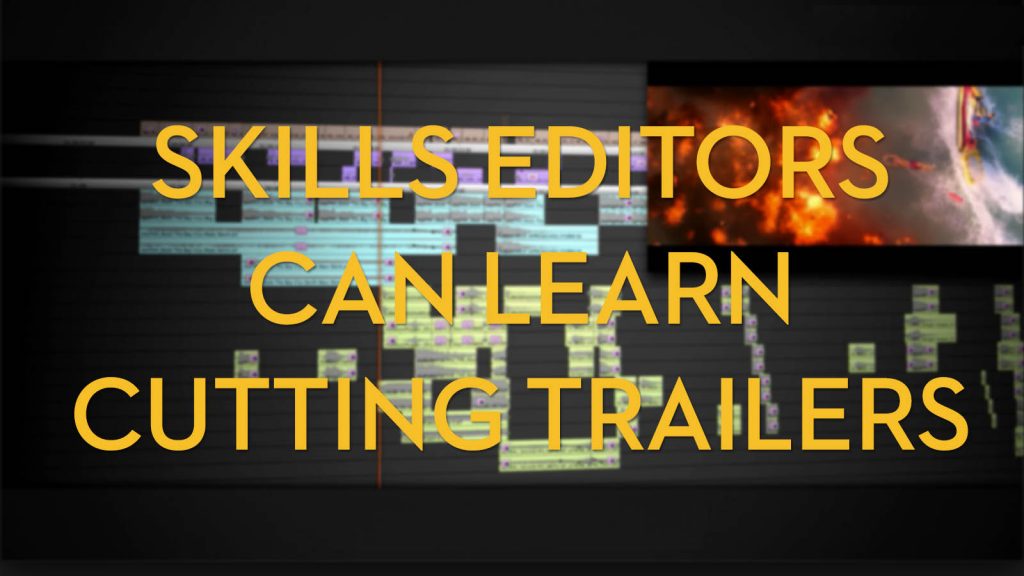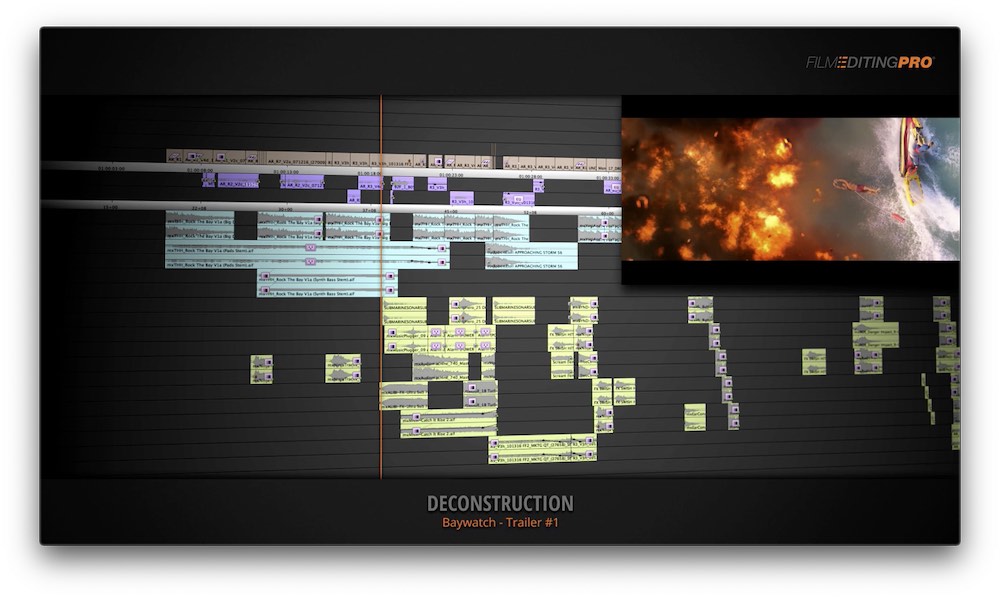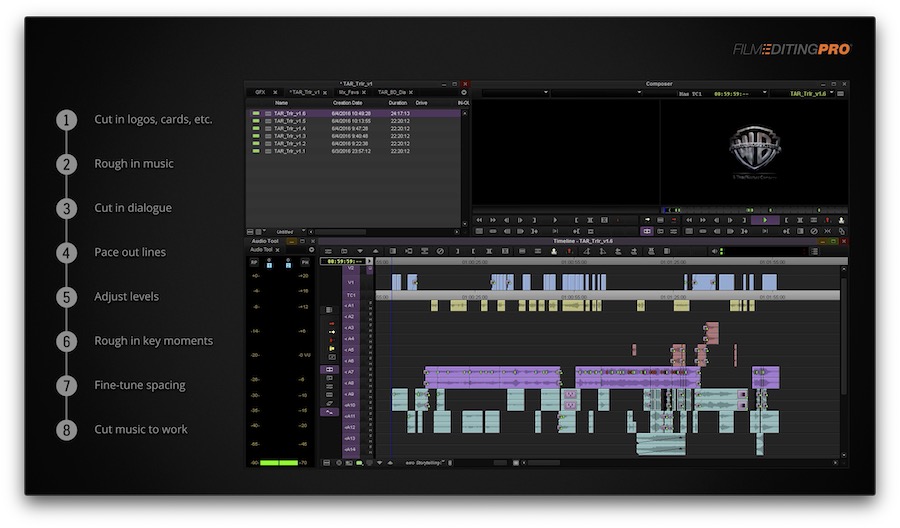Skills Editors Can Learn from Cutting Trailers

If you’re an editor who has never cut a trailer before, then I’d highly recommend that you do!
Learning how to edit a trailer is a valuable training experience that will certainly push you to think in new ways, add creative and technical abilities to your existing skillset and force you to think about storytelling, music editing and sound design in fresh ways.
In this post I want to share five things I’ve learned from Film Editing Pro’s valuable 45 minute free mini-course on editing trailers, backed up by my own experience of editing trailers over the years in my freelance work.
Even if you have cut plenty of promos or trailers before, it’s still well worth taking 45 minutes to watch all of the free training, not only will you get to see how someone else does it, but there are some great professional insights to be gained on music editing, story structure and sound design, which are all key to a successful trailer.
If you want even more free tutorials, trailer editing breakdowns, free trailer sound effects and in-depth interviews with professional trailer editors check out these two previous posts:
To jump straight into the free trailer editing training just drop you email address in here to get access to these three lessons:
- Trailer Editing 101: The Secrets of the Craft
- Trailer Sound Design and Music Techniques
- Trailer Editing Behind the Scenes: Deconstructing the Cut
The third and final lesson is a real treat as it provides a detailed breakdown of the first trailer for the action comedy Baywatch.
All of this free training is provided to give you a taste of what the full 40+ lesson course, Art of Trailer Editing has to offer, which includes:
- 42 detailed trailer editing video lessons
- 1080p downloadable practice footage with split audio tracks to follow along with
- A 950+ piece trailer editing music & sound design library
- Custom trailer graphics and script pack
And, if you upgrade to the Pro version, you’ll also get:
- 100+ minutes of video interviews with trailer editors
- An additional 1200-piece Pro Trailer Sound Design Pack
- 4 more trailer deconstruction videos for comedy, action, drama and suspense genres
- The Pro Graphic & Script Pack with 3 extra graphic looks
Film Editing Pro are opening enrolment for their excellent Art of Trailer Editing course from today, 4th March until the 10th of March 2021.
So if you’re interested in the full course – don’t delay!

Most (course students) didn’t realise how tough it is and were excited to learn a new set of trailer-specific editing techniques.
There are a lot of haters on the internet who like to think that a trailer is just a bunch of clips strung together with music underneath. That’s obviously a dramatically reductive and naïve assessment of an incredibly complicated style of editing.
Cutting a trailer is a whole different animal from what most editors are used to.
Chris, Film Editing Pro
If you want to learn more about the 18 month journey that Film Editing Pro went through to create the course, you can check out my short interview with Chris from Film Editing Pro in this previous post.
5 Lessons from The Art of Trailer Editing

Here are five lessons I’ve learned, of many more, from The Art of Trailer Editing – both the mini-course, the full course and Film Editing Pro’s free tasters from their courses on their YouTube channel.
- How to compress time in your edit
- How to re-cut music tracks to shorter lengths
- Why you need to keep tightening the trailer
- Sound effects are essential to add intensity
- Trailers require creative approaches to stand out from the formula
I hope you find them interesting and informative, it also helps if you watch a lot of trailers… and who doesn’t love doing that?
1. How to compress time in your edit
One of the major skills that cutting a trailer gives you is the ability to compress time in your edits. By this I mean the ability to take, for example, a 2 minute joke and compress it down into 30 seconds or less. Or maybe even just three lines.
On a bigger scale the trailer has to compress a two hour movie into a two minute promo that is not only interesting to watch in itself but also communicates why people should go and see the film as well.
One way to practice this shortening today, is to take a project you’ve already edited and try to tell it in half the time, or a quarter of the time, or just 30 seconds. You have to be brutal but also surgically precise – it’s a great skill to master!
Being able to select the right lines of dialogue, write the perfect voice over or construct the correct title cards to communicate the essential information takes time to practice and meticulous preparation.
The Film Editing Pro video above demonstrates some effective techniques to do this properly.
A common trick that is used in trailers to make a character say the exact words that are needed for that moment in the promo is to take several different lines and mash them together, whilst hiding the majority of the dialogue off-screen or ‘pasting’ it onto the back of their head.
In the TENET trailer above most of the opening voice over is off-screen, until the final line at 42 seconds in. I can’t remember for sure what the full speech is in the final film but I’m sure it is highly edited.
Another example of cheating lines, are the final lines in the trailer for the ‘button’, where “What happened here?” seems to be cheated into the mouth of Robert Pattinson behind a convenient bullet hole.
Learn from my mistakes – Get Your Cards in Early
Make sure you get your cards in early for structure, to communicate key lines and make sure your placeholders are the correct duration for legibility and legal.
It’s a time intensive pain in the butt to have to re-work your final trailer just so that you can find an extra second or even a few frames in your final cut all because you got the temp graphics wrong.
This short video from Film Editing Pro’s Youtube channel walks you through all the common cards in a trailer such as:
- Green/Red Cards
- Studio Logos
- Date Cards
- Copy Cards
- Pedigree Cards
- Title Cards
- End Cards/Billing Blocks
- Buttons
2. How to re-cut music cues to shorter lengths for maximum impact

Most of the time when you’re cutting a trailer you won’t actually be editing one trailer but a whole package of trailers that are likely to include a 2.30 mins, 1 min, 30 seconds, 15 second and even 5 second spots.
Most of the time once the longest trailer is signed off in terms of content, music and approach the others will be derivative of this work, which makes creating the shorter edits, easier.
In general, the shorter the overall duration the less time there is for gentle builds, tension relieving breathing room or even entire music cues.
The ending will almost always want a climatic crescendo to a final card, usually the release date, so it sometimes helps to work backwards from what you want to keep of that section of the trailer.
Additional music stops accented by whooshes and hits can also help to compress your music tracks into shorter and shorter spaces.
There are some great lessons in the full trailer editing course that expound on all of this!
3. Why you can’t tighten the edit enough
One of the things that happens when you start working on a trailer is that you soon learn you can’t tighten it enough.
Yes you need room for jokes to land or moments of tension to be relieved but any flab is easily seen. Especially if you’ve spent more time on one section than on others.
You need to be rigorous about adding sound effects to all entries and exits of title cards and music cues, adding audio accents to dramatic visual movements or moments, ensuring the mix is as taught as possible – yet still being able to hear everything clearly and so much more.
Not to mention working the visuals to best ‘sell’ the film, without giving everything away, by selecting key closes ups of the stars, the biggest action moments or anything that will give the trailer pace and energy – even if it’s just the obligatory ‘run to the airport’ in a rom-com.
Even though you’re only producing a few minutes of total run time, trailer editors can spend weeks (if not months) editing and re-editing those same few minutes of final work.
One way to check your work is to go back and turn off the picture, play through the edit and make sure there aren’t any unnecessary bald spots in your sound design.
Then turn off the sound and make sure all the visuals all flow from one to the other, that in-frame movement connect across cuts, and that the pace of the cuts is ramping up in all the right places.
Then turn everything back on and double check that all your hits and cuts, visual and auditory are landing together, that any pulsing fades are rhythmically correct and so on.
4. Sound Effects are essential to add greater intensity
In the third free lesson from the Film Editing Pro mini-course, which breaks apart the timeline of the 2.30 min Baywatch trailer, you’ll see how often a whoosh and a hit is used to end a music cue, land a title card or re-start the pace of the trailer from a moment of dialogue only comedy.
In this further 3 minute sample from the mini-course (embedded above) you can check out a before and after breakdown of the difference adding a ‘hit grid’ of impact sounds and other layers of further sound design on top of existing drum beats in a music track can increase the effective intensity of the trailer, especially towards it’s final act.
Without these additional hits and sound design elements the trailer won’t necessarily be able to ‘punch above its weight’, so working all of these extra sound effects in, adds layers of ‘muscle’ to the trailer, giving it a greater impact.
It is also interesting to note that the trailer is build from the ground up with a ‘radio-edit’ of just the music, dialogue and sound effects and the visual are “often added last“.
5. Trailers require creative approach to break out from the formula
As this funny but true trailer for trailer structure from Auralnauts demonstrates most modern trailers fit a shockingly similar structure/sound/feel/approach, which definitely has strains of TENET and Mission Impossible: Fallout and the Joker trailer too.
Now it’s well worth studying that pattern to understand how it works, and again the audio only nature of the Auralnauts video proves that radio-edit first, is a viable way to build a trailer before layering in as many impressive visuals as you can.
Although now maybe we’ve hit peak ‘this kind of trailer’, given that the trailer for Cruella follows the same pattern as Joker and Harley Quinn’s Birds of Prey and I’m really confused quite who it’s for.
Is it for kids??
But if you can create a trailer that stands against the rest of the ‘norm’ then you’re more likely to get noticed. For example, back in 2016, the Suicide Squad trailer got noticed for it’s music-centric edit or the (initially) more sonically restrained The Dark Knight Rises trailer from 2011.
What will the next ‘really different’ trailer look like?
Several years ago I included this original trailer structure video from Auralnauts in this previous post on editing trailers, and when you watch them back to back today, it’s interesting to see how much and how little has changed in that time span.




